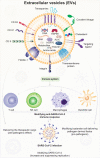A Role for Extracellular Vesicles in SARS-CoV-2 Therapeutics and Prevention
- PMID: 33544324
- PMCID: PMC7862527
- DOI: 10.1007/s11481-020-09981-0
A Role for Extracellular Vesicles in SARS-CoV-2 Therapeutics and Prevention
Abstract
Extracellular vesicles (EVs) are the common designation for ectosomes, microparticles and microvesicles serving dominant roles in intercellular communication. Both viable and dying cells release EVs to the extracellular environment for transfer of cell, immune and infectious materials. Defined morphologically as lipid bi-layered structures EVs show molecular, biochemical, distribution, and entry mechanisms similar to viruses within cells and tissues. In recent years their functional capacities have been harnessed to deliver biomolecules and drugs and immunological agents to specific cells and organs of interest or disease. Interest in EVs as putative vaccines or drug delivery vehicles are substantial. The vesicles have properties of receptors nanoassembly on their surface. EVs can interact with specific immunocytes that include antigen presenting cells (dendritic cells and other mononuclear phagocytes) to elicit immune responses or affect tissue and cellular homeostasis or disease. Due to potential advantages like biocompatibility, biodegradation and efficient immune activation, EVs have gained attraction for the development of treatment or a vaccine system against the severe acute respiratory syndrome coronavirus 2 (SARS CoV-2) infection. In this review efforts to use EVs to contain SARS CoV-2 and affect the current viral pandemic are discussed. An emphasis is made on mesenchymal stem cell derived EVs' as a vaccine candidate delivery system.
Keywords: Coronavirus disease 2019 (COVID-19); Extracellular vesicles (EVs); Mesenchymal stem cells (MSCs); Severe acute respiratory syndrome coronavirus 2 (SARS-CoV-2).
Figures


Similar articles
-
Emerging roles of extracellular vesicles in COVID-19, a double-edged sword?Immunology. 2021 Aug;163(4):416-430. doi: 10.1111/imm.13329. Epub 2021 May 4. Immunology. 2021. PMID: 33742451 Free PMC article. Review.
-
Extracellular Vesicles in COVID-19: Mechanistic insights and emerging therapeutic strategies.An Acad Bras Cienc. 2025 May 12;97(2):e20241216. doi: 10.1590/0001-3765202520241216. eCollection 2025. An Acad Bras Cienc. 2025. PMID: 40366930 Review.
-
COVID-19 and Extracellular Vesicles: An Intriguing Interplay.Kidney Blood Press Res. 2020;45(5):661-670. doi: 10.1159/000511402. Epub 2020 Sep 21. Kidney Blood Press Res. 2020. PMID: 32957112 Free PMC article. Review.
-
Extracellular Vesicles as a Translational Approach for the Treatment of COVID-19 Disease: An Updated Overview.Viruses. 2023 Sep 22;15(10):1976. doi: 10.3390/v15101976. Viruses. 2023. PMID: 37896755 Free PMC article. Review.
-
Potential therapeutic applications of extracellular vesicles in the immunopathogenesis of COVID-19.Pathol Res Pract. 2023 Jan;241:154280. doi: 10.1016/j.prp.2022.154280. Epub 2022 Dec 17. Pathol Res Pract. 2023. PMID: 36580795 Free PMC article. Review.
Cited by
-
Nanoparticle-Based Delivery Systems for Vaccines.Vaccines (Basel). 2022 Nov 17;10(11):1946. doi: 10.3390/vaccines10111946. Vaccines (Basel). 2022. PMID: 36423041 Free PMC article. Review.
-
mRNA-Based Vaccines and Therapeutics for COVID-19 and Future Pandemics.Vaccines (Basel). 2022 Dec 15;10(12):2150. doi: 10.3390/vaccines10122150. Vaccines (Basel). 2022. PMID: 36560560 Free PMC article. Review.
-
Extracellular Vesicles: Versatile Nanomediators, Potential Biomarkers and Therapeutic Agents in Atherosclerosis and COVID-19-Related Thrombosis.Int J Mol Sci. 2021 May 31;22(11):5967. doi: 10.3390/ijms22115967. Int J Mol Sci. 2021. PMID: 34073119 Free PMC article. Review.
-
Advances in developing ACE2 derivatives against SARS-CoV-2.Lancet Microbe. 2023 May;4(5):e369-e378. doi: 10.1016/S2666-5247(23)00011-3. Epub 2023 Mar 16. Lancet Microbe. 2023. PMID: 36934742 Free PMC article. Review.
-
Aspects of Nanotechnology for COVID-19 Vaccine Development and Its Delivery Applications.Pharmaceutics. 2023 Jan 30;15(2):451. doi: 10.3390/pharmaceutics15020451. Pharmaceutics. 2023. PMID: 36839773 Free PMC article. Review.
References
-
- Ahn SY, Park WS, Kim YE, Sung DK, Sung SI, Ahn JY, Chang YS. Vascular endothelial growth factor mediates the therapeutic efficacy of mesenchymal stem cell-derived extracellular vesicles against neonatal hyperoxic lung injury. Exp Mol Med. 2018;50:26. doi: 10.1038/s12276-018-0055-8. - DOI - PMC - PubMed
Publication types
MeSH terms
Substances
Grants and funding
LinkOut - more resources
Full Text Sources
Other Literature Sources
Miscellaneous

